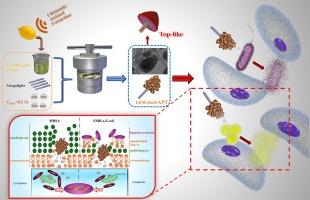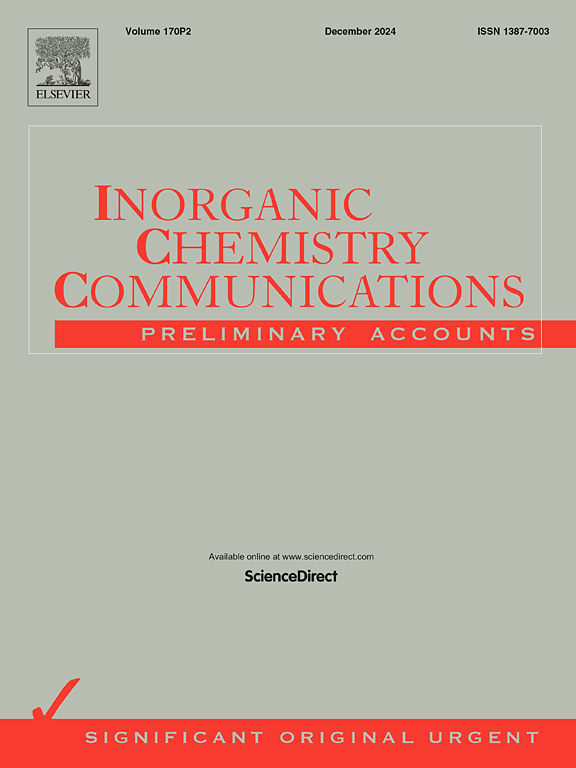利用柠檬皮提取物通过植物介导合成氧化锌/阿塔帕石纳米复合材料,增强对耐多药细菌和真菌的抵抗力
IF 5.4
3区 化学
Q1 CHEMISTRY, INORGANIC & NUCLEAR
引用次数: 0
摘要
氧化锌在对抗耐多药(MDR)细菌方面具有巨大潜力,但绿色合成和活性调控仍面临挑战。在本研究中,我们设计了一种以柠檬皮提取物为介导的绿色生物启发方法,合成了一系列阿塔蓬石(APT)支撑的 ZnO 纳米复合材料,用于增强对 MDR 致病细菌和真菌的抵抗力。XRD 和 TEM 分析表明,通过调节 Zn2+ 离子的浓度,成功合成了具有独特钉顶状形貌和清晰晶体结构的 ZnO/APT。XPS 结果证实,与纯 ZnO(呈立方体)相比,由于 APT 对 ZnO 结构的调节,氧空位显著增加。所获得的 ZnO/APT 纳米复合材料具有良好的生物相容性和更强的抗菌功效,浓度为 0.125 mg/mL 时可完全抑制 MRSA,浓度为 0.5 mg/mL 时对 ESBLs 大肠杆菌的抑制率高达 94.68 ± 1.43%,浓度为 0.25 mg/mL 时对白僵菌的抗真菌率为 95.59 ± 1.08%。此外,与纯 ZnO 相比,ZnO/APT 具有良好的止血效果和更强的生物相容性。该研究为设计抗菌效果显著、细胞毒性较低的高效氧化锌抗菌纳米材料提供了一条绿色途径,氧化锌/APT纳米复合材料具有临床应用潜力。本文章由计算机程序翻译,如有差异,请以英文原文为准。

Phyto-mediated synthesis of ZnO/attapulgite nanocomposites using C. limon peel extract for enhancing the resistance against multidrug-resistant bacteria and fungi
ZnO have great potential in combating multidrug-resistant (MDR) bacteria, however, green synthesis and activity regulation still face challenges. In this study, we designed a green bioinspired method mediated by C. limon peel extract to synthesise a series of attapulgite (APT) supported ZnO nanocomposites for enhancing the resistance against MDR pathogenic bacterial and fungal, in which the structure and morphology of ZnO was regulated by APT inducing heterogeneous nucleation of ZnO, thus enhancing the antibacterial activity of the nanocomposites. XRD and TEM analysis demonstrated that ZnO/APT with a unique peg-top-like morphology and well-defined crystal structure was successfully synthesized via the regulation of Zn2+ ions concentration. XPS results confirmed that the oxygen vacancy increased significantly compared with the pure ZnO (has a cubic shape) due to the structural modulation of ZnO induced by APT. The obtained ZnO/APT nanocomposites exhibited excellent biocompatibility and enhanced antibacterial efficacy with a complete inhibition at a concentration of 0.125 mg/mL for MRSA, a high inhibitory rate of 94.68 ± 1.43 % at a concentration of 0.5 mg/mL for ESBLs-E. coli, and the antifungal rate against C. albicans was found to be 95.59 ± 1.08 % at a concentration of 0.25 mg/mL. In addition, the ZnO/APT had a good hemostatic effect and enhanced biocompatibility compared to pure ZnO. The study provides a green way to design efficient ZnO antibacterial nanomaterials with remarkable antimicrobial efficacy and lower cytotoxicity, and the ZnO/APT nanocomposite is potential for clinical applications.
求助全文
通过发布文献求助,成功后即可免费获取论文全文。
去求助
来源期刊

Inorganic Chemistry Communications
化学-无机化学与核化学
CiteScore
5.50
自引率
7.90%
发文量
1013
审稿时长
53 days
期刊介绍:
Launched in January 1998, Inorganic Chemistry Communications is an international journal dedicated to the rapid publication of short communications in the major areas of inorganic, organometallic and supramolecular chemistry. Topics include synthetic and reaction chemistry, kinetics and mechanisms of reactions, bioinorganic chemistry, photochemistry and the use of metal and organometallic compounds in stoichiometric and catalytic synthesis or organic compounds.
 求助内容:
求助内容: 应助结果提醒方式:
应助结果提醒方式:


